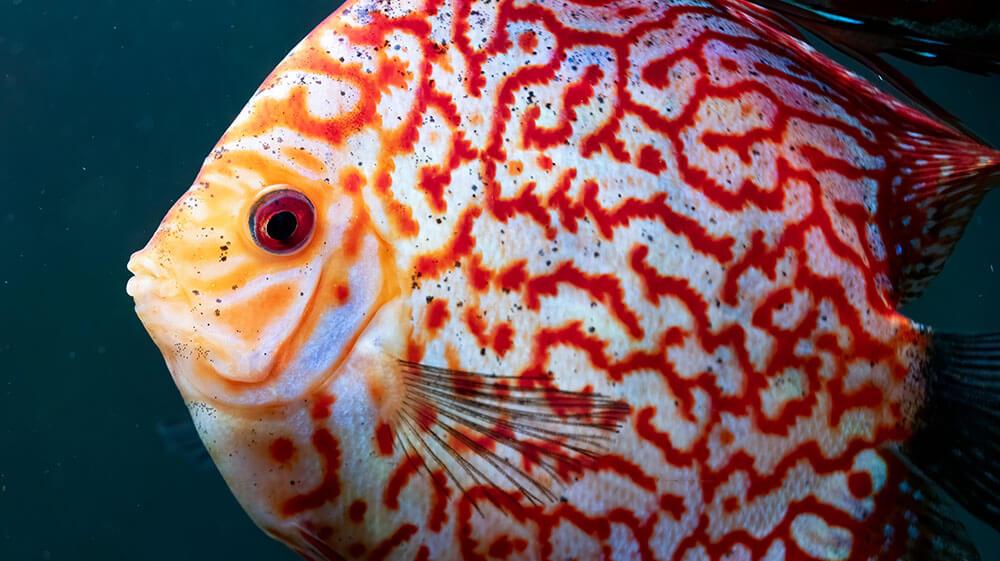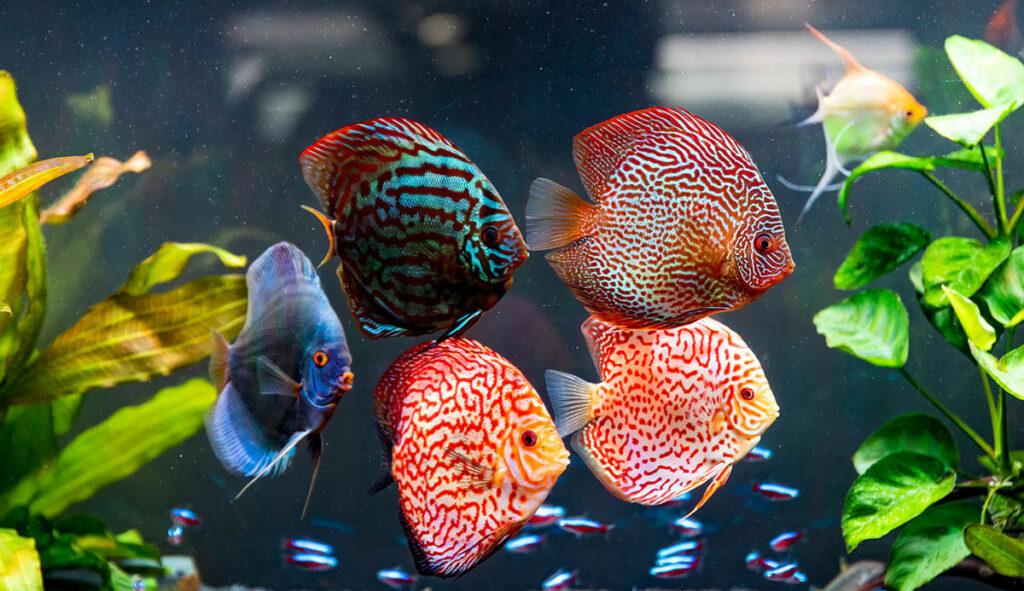Discus fish keeping techniques
Discus Fish Breeding Techniques: A Comprehensive Guide (MOST COMPLETE)
Table of Contents
Introducing Discus Fish
Five-Colored Celestial Beings – Regal Beauty in the Aquatic World
Discus fish, also known as the “five-colored celestial beings,” are among the most beloved aquarium fish worldwide. With their round, flat bodies and vibrant, diverse colors resembling a living painting, discus fish are truly a masterpiece of nature. Not only do they possess elegant beauty, but their gentle, graceful swimming also creates a serene atmosphere for anyone who observes them.
Breeding Techniques – The Key to Radiant Colors
However, to allow discus fish to fully showcase their hidden beauty and live a long and healthy life, breeders need to master the proper breeding techniques. From setting up an ideal living environment and selecting healthy fish to providing a proper diet and daily care, everything plays a vital role in ensuring the discus fish develop comprehensively, display vibrant colors, and live a long life in your aquarium.
Let’s explore the colorful world of discus fish together and learn the necessary breeding techniques so you can confidently create a stunning “living picture” right in your own home.
Preparing the Breeding Environment – Laying the Foundation for Discus Fish Development
The Aquarium – An Ideal Home for the “Five-Colored Celestial Beings”
Size:
Discus fish need space to swim comfortably and fully express their beauty. Therefore, the size of the aquarium is very important.
Golden Rule: Provide at least 20 liters of water for each adult discus fish (size 11cm or larger). If raising multiple fish, increase the aquarium size accordingly.
Materials: Glass: This is the top choice for discus fish aquariums. Glass tanks are not only transparent, highlighting the vibrant beauty of the fish, but also easy to observe and monitor their health.
Decorations: Depending on the hobbyist’s preference, aquatic plants may or may not be planted. If planting, choose plants that live at the same temperature as discus fish, from 25-30 degrees Celsius, such as:
- Java Fern (Microsorum pteropus)
- Anubias Coffeefolia (Anubias barteri var. ‘coffeefolia’)
- Anubias Nana (Anubias barteri var. nana)
- Ludwigia Repens (Ludwigia repens)
- Blyxa Japonica (Blyxa japonica)
- …
Rocks and Driftwood: Create additional accents and hiding places for the fish. Choose rocks and driftwood with natural shapes, without sharp edges to avoid injuring the fish.
Note: All plants and decorations should be thoroughly cleaned before being placed in the aquarium to avoid introducing pathogens to the fish.
Water – The Essential Element
Water Source:
Tap water should be left in the open air for at least a day (or use a chlorine remover) to dechlorinate. Well water should be filtered, disinfected with chlorine, and then dechlorinated before adding fish.
Water Parameters:
- Temperature: 25-30°C (ideally 28°C)
- pH: 6.0 – 6.5 (Not exceeding 7)
- Hardness (GH): 1 – 4 dGH
- Ammonia (NH3) and Nitrite (NO2): 0 ppm
- Nitrate (NO3): < 20 ppm (No need to worry about hardness, ammonia, and nitrate levels for non-commercial breeding. A properly designed filter system will remove ammonia and nitrate)
- Oxygenation 24/7
Filter Equipment: Filtration is crucial for keeping the aquarium water clean and ensuring the fish’s health. Choose a filter with a capacity suitable for the aquarium size and the number of fish.
Refer to filter design instructions here
Lighting and Heating – Maintaining Life
Lighting: Provide moderate lighting, avoiding excessive brightness. Strong light can stimulate the growth of algae, stress the fish, and cause black pepper disease. Use LED or fluorescent lights specifically designed for aquariums.

Heating: Maintain a stable water temperature between 25-30°C using a heater with a capacity suitable for the aquarium size. Use a thermometer to monitor the water temperature regularly.
Note: The stability of the water environment is key to the health of discus fish. Avoid sudden changes in water parameters, as this can shock and affect the fish’s health.
Selecting and Introducing Fish
Choosing Healthy Fish
Observe Carefully: Take the time to observe the fish in the tank at the store. Check the following factors carefully:
- Color: The fish’s color should be bright and clear, without fading or strange spots.
- Fins: The fins should be intact, not torn, frayed, or have white spots.
- Eyes: The eyes should be clear, not cloudy or protruding.
- Behavior: Healthy fish will swim actively and respond quickly to their surroundings. Avoid fish that are lethargic, lying still, hiding in corners, or swimming abnormally.
Avoid fish with signs of disease: Some common signs of disease in fish include:
- White spots on the body or fins
- Torn, frayed, or white-spotted fins
- Cloudy or protruding eyes
- Abnormally swollen belly
- Rapid breathing or abnormal swimming
Introducing Fish to the Aquarium
Equalize Water Temperature: This is a crucial step to prevent the fish from experiencing temperature shock.
Place the unopened bag of fish in the new aquarium for about 15-20 minutes. This allows the water temperature in the bag to gradually equalize with the water temperature in the aquarium.
Then, open the bag and slowly add a little water from the aquarium into the bag. Repeat this step a few times over 10-15 minutes. (While opening the bag, remember to insert an oxygen tube into the bag).
Release the Fish Slowly:
Gently tilt the bag and let the fish swim out on their own. Avoid pouring the fish directly from the bag into the aquarium. Observe the fish for the first few days to ensure they adapt well to the new environment.
- Note: Within 24 hours after releasing the fish, do not feed the fish.
Discus Fish Care
Discus fish are beautiful ornamental fish but also quite sensitive, requiring meticulous care and specific knowledge. Here are some basic guidelines to help you care for discus fish so they stay healthy and thrive.
Feeding
Suitable Food: Discus fish are carnivores, you can feed them the following types of food:
- Bloodworms (live or frozen)
- Frozen brine shrimp
- Frozen beef heart mix (See How to mix beef heart for discus fish)
Adequate Food, Avoid Excess: Feed the fish enough food for them to finish within 5-10 minutes. Excess food will pollute the water and affect the fish’s health.
Feeding Frequency: Feed the fish 2-4 times a day, depending on their size and age. Younger fish need to be fed more frequently than adults. (2 times is reasonable for regular aquarium hobbyists, morning and evening)
Aquarium Cleaning
Regular Water Changes: Change 20-30% of the water in the aquarium every week to remove waste and maintain good water quality. (If changing less than 20% of the water, you can add tap water directly to the aquarium)
Vacuum Gravel: Use a gravel vacuum to remove leftover food, fish waste, and other debris from the bottom of the aquarium.
Clean the Filter Regularly: Clean the filter components according to the manufacturer’s instructions to ensure efficient filtration.
Health Monitoring
Observe the Fish Daily: Take the time to observe the fish every day to detect early signs of disease such as:
- Loss of appetite
- Abnormal swimming
- Appearance of white spots or ulcers on the body
- Cloudy or swollen eyes
- Torn or frayed fins
Isolate sick fish, then depending on the case, treat them according to the Discus fish disease prevention and treatment methods here.
Conclusion
Raising discus fish is an elegant hobby but also requires investment in time, effort, and knowledge. To succeed, breeders need to master basic techniques, from selecting healthy fish and setting up a suitable living environment to providing a proper diet and regular health care.
In summary, the key points in discus fish breeding techniques include:
- Choose healthy fish with no signs of disease.
- Set up the aquarium with a stable water environment, an efficient filter system, and aeration.
- Feed the fish high-quality food in the right amount and frequency.
- Clean the aquarium regularly and perform water changes periodically.
- Observe the fish daily to detect early signs of disease and take timely action.
Besides the basic knowledge above, discus fish breeders should also continuously seek additional information and experience from reputable sources like Trai Ca 247 to improve their skills and knowledge.
Wish you success in raising and caring for beautiful, healthy, and vibrant discus fish! Let these discus fish bring joy and relaxation to your life.


 Vietnamese
Vietnamese